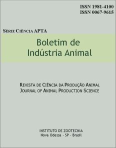Genetic and environmental factors in natural infestation of tick (Boophilus microplus, Canestrini in dairy heifers)
Abstract
It was studied 610 records of heifers from 1 to 2 years old of €œMantiqueira€ type and bom from 12 sires. During 2 years and in the midle of each season of the year all heifers had their natural infestation by semi-ingurgitated female tick counted on the right side of the body. These heifers received a tub bath with chemical products 35 days before each counting. Year effect was not significant, but season effect was highly significant and the following averages were: spring = 21.73; summer 73.75; fall = 93.10; and winter = 9.72%. The age effect was not important during the growing period for tick infestation. Heritability estimated by paternal half sib correlation was 0.186 ± 0.121 with an average of 49.58 ± 6.48 €œteleóginas€ by animal. These results demonstrated that studies of tick infestation must be done during summer and fall season, regardless of the age of the animal, and some genetic gain could be get through selection of these heifeirs.Downloads
Downloads
Published
Issue
Section
License
Os autores não serão remunerados pela publicação de trabalhos, pois devem abrir mão de seus direitos autorais em favor deste periódico. Por outro lado, os autores ficam autorizados a publicar seus artigos, simultaneamente, em repositórios da instituição de sua origem, desde que citada a fonte da publicação original seja Boletim de Indústria Animal. A revista se reserva o direito de efetuar, nos originais, alterações de ordem normativa, ortográfica e gramatical, com vistas a manter o padrão culto da língua e a credibilidade do veículo. Respeitará, no entanto, o estilo de escrever dos autores. Alterações, correções ou sugestões de ordem conceitual serão encaminhadas aos autores, quando necessário. Nesses casos, os artigos, depois de adequados, deverão ser submetidos a nova apreciação. As opiniões emitidas pelos autores dos artigos são de sua exclusiva responsabilidade. Todo o conteúdo deste periódico, exceto onde está identificado, está licenciado sob a Licença Creative Commons Attribution (CC-BY-NC). A condição BY implica que os licenciados podem copiar, distribuir, exibir e executar a obra e fazer trabalhos derivados com base em que só se dão o autor ou licenciante os créditos na forma especificada por estes. A cláusula NC significa que os licenciados podem copiar, distribuir, exibir e executar a obra e fazer trabalhos derivados com base apenas para fins não comerciais.













